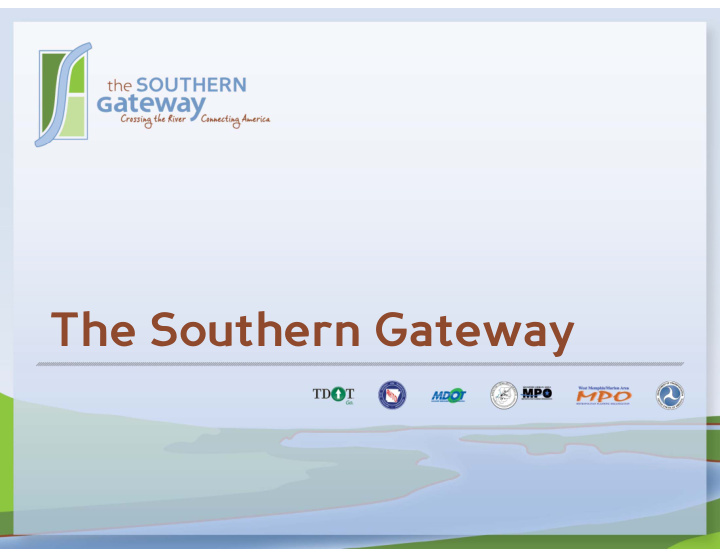



The Southern Gateway The Southern Gateway
Metropolitan Memphis • A vital gateway for moving people and freight • Home to critical transportation infrastructure – Railroads, Airport, Inland Port, Interstates • Four Mississippi River Bridge crossings – Frisco (railroad): 1892 Frisco (railroad): 1892 – Harahan (railroad): 1916 – Memphis ‐ Arkansas (I ‐ 55): 1949 Memphis Arkansas (I 55): 1949 – Hernando de Soto (I ‐ 40): 1973
Challenges Ahead • Growing population = more congestion • More demands on aging infrastructure • More demands on aging infrastructure • Seismic concerns • Increases in national freight movement and commerce • Economic vitality of Metropolitan Memphis and the region depends on efficient infrastructure • Safety, security and y, y emergency response
Previous Studies • Broad studies to determine f feasibility of new corridors & b l f d & bridge locations • Preliminary data and analyses • 13 corridors & several highway g y crossing locations considered • Determined that a new Determined that a new bridge is feasible • More detailed studies needed • More detailed studies needed From: Mississippi River Crossing Feasibility and Location Study
The Southern Gateway Project Purpose: – To identify deficiencies in the existing transportation system – To identify better connections for people and freight through th M the Memphis area to the tri ‐ state region and the country hi t th t i t t i d th t
Partners • Tennessee Department of Transportation (lead agency) • Arkansas State Highway and Transportation Department • Mississippi Department of Transportation p • Federal Highway Administration (Divisions in each state) (Divisions in each state) • Memphis and West Memphis Metropolitan Planning Organizations Metropolitan Planning Organizations
More Than a Bridge • Consider multiple modes of transportation • Highway • Freight & Passenger Rail • Bicycle/Pedestrian • Analyze funding options • Consider regional and national Consider regional and national economic impacts
Multi-Year Effort • Environmental and Planning Process • Required for projects that use Federal funding or require Federal permits • Results in an Environmental Impact Statement (EIS) leading to a Record of Decision g • The EIS will Mock up Mock-up – serve as the basis for future – serve as the basis for future Cover of design and construction efforts EIS – demonstrate compliance with applicable demonstrate compliance with applicable environmental laws
Study Area
Areas of Focus • Engineering – Traffic, operations, cost to construct and maintain, funding • Impacts on the natural environment – Wetlands, threatened /endangered species, air & water quality • Impacts on the man ‐ made environment – Historical and archaeological sites, public recreation lands
Areas of Focus • Safety and Mobility – Access to jobs, schools, shopping and other services • Social Impacts – Relocations, neighborhood changes, economic impacts • Public Involvement
The EIS Process • Purpose and Need Statement – Identifies issues to be addressed and reason for project – Benchmark to evaluate competing alternatives • Alternatives Development – Develop up to seven 2 ‐ mile wide corridors D l 2 il id id – Collect data and conduct preliminary analysis – Reduce to four corridors and narrow to 2,000 feet wide – Additional data collection and analysis – Reduce to three corridors for detailed evaluation
The EIS Process • Alternatives Evaluation Alternatives Evaluation – Develop improvement options within each corridor – Conduct detailed technical evaluations Conduct detailed technical evaluations – Identify potential “build alternatives” • Identify Preferred Alternative – Evaluate the build alternatives in the Draft EIS Evaluate the build alternatives in the Draft EIS – Document impacts on the natural & man ‐ made environments – Select preferred alternative Select preferred alternative
The EIS Process • Documentation & Decision Documentation & Decision – DEIS reviewed by the public and multiple agencies – Final EIS identifies preferred alternative, confirmed in a Final EIS identifies preferred alternative confirmed in a Record of Decision
Schedule
Public Involvement • Important part of the process • Conducted at all stages of project development • Meetings, hearings, workshops, presentations, p , p , small group sessions, etc. • Project website and email Project website and email address = 24 hour access to information to information
When Will Improvements Happen? • Environmental process – May result in a preferred build alternative – Must be finalized & approved b f before design or construction begin d i i b i – Projected EIS completion is 2015 • Future steps depend on funding – Federal, state, local and/or private • EIS will include study of funding options such as tolling and public ‐ private partnerships
Contact Us www.southerngatewayproject.com
QUESTIONS?
Recommend
More recommend